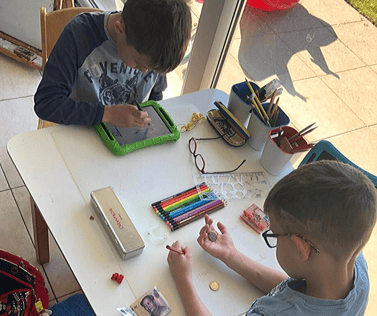Although we are currently living in unprecedented times, homeschooling is nothing new.
It was established as a viable educational path many years ago and over time, people have developed a number of healthy habits and tricks to make the process smoother and easier. Of course, in this case, many parents are having to check on their children’s progress whilst also working from home themselves. We have therefore compiled a list of tips and ideas to help families through this singular moment in history.
1 – Designate a work space
When working from home, it is important to choose a space that will henceforth become ‘the classroom’.
A study conducted on remote workers found that many prefer to work in a home office or the living room rather than in one’s bedroom which is often associated with relaxation and leisure, rather than work. Many children and older students will also have difficulty separating ‘school time’ from downtime if they begin to blur the boundaries of home and school life in such a way.
For that reason, try and establish one place in your home as the ‘work space’, where students will know when they take their seat that they are there to work. This should help them settle into ‘school mode’ more smoothly in the morning.
2 – Clear distractions from that space
One of the hardest things about being at home without a teacher or a boss is resisting distraction. It may be useful, therefore, to remove any toys and devices that could distract younger children and confuse their work-play boundaries.
Older students may feel more distracted by online websites and social media. For them, browser extensions like Limit, Stay Focused (on Chrome) or Waste No Time (Chrome or Safari) could be very useful, as they enable students to block their own access to websites to which they subconsciously migrate and which inhibit their productivity.
Students can also use apps like Forest to discourage them from picking up their phones, or even impose a phone ban whilst they work by keeping it out of the room so that they are not tempted to look at it. Simple hacks like these are a way for students to impose their own teacher-like authority in their work space, taking the tools for distraction out of their hands and keeping them on track.
3 – Establish a routine
If getting into ‘work mode’ at home is tricky, students could try imagining a barrier going down in their mind when they begin in the morning, and rising again at the end of the day. For visual learners, this is a good way to see the start and end of a work day when your surroundings do not necessarily change.
What’s more, by setting specific start times, break times and end times, students will be able to focus better during the allotted work periods. Starting work at different times every day will make it harder to settle into a routine and keep up the learning in the long run. Having a structure will replicate the framework of the school day and this familiarity will give students the motivation to take their work seriously.

4 – Keep up communication
Remote workers say that loneliness is a factor of working at home with which they often contend. That is why work sharing tools like Dropbox and Google Docs could be beneficial for older students. By sharing resources or even their screens with their classmates, and organising remote calls through video call software like Zoom or Skype, they can maintain the feeling of working in a classroom. Even if calls are to simply feel the presence of a friend on the other end of the line, they can create a feeling of solidarity and closeness when students are not in the same physical space.
Studies show that 42% of remote workers enjoy having music playing when they work from home, even just ambient or meditative sounds, whilst 25% like to have the hum of the TV on in the background. Students might find that these are good ways to continually feel connected to the world whilst they are at home (although at this current time, it is perhaps advisable not to have the news on loop in the background).
5 – Allow a few treats to make it fun!
By treats, we don’t mean a big box of doughnuts! However, if homeschooling is new to students, it can feel a little unnatural to get into right away.
To make the experience more positive and appealing, consider stocking up on a few nice items like interesting teas, new stationery or coloured pens to bring notes to life … Essentially, anything that students might not necessarily have when in school that won’t distract from work, but that can help compensate for missing their friends or usual routine.
6 – Make time for good mental health
Working from home is great for productivity, but it is also essential to separate work time from home time, and to allow breaks throughout the day, just as students would at school.
If you have the privilege of owning a garden, make sure that your children get outside and get some fresh air. Students may also want to disassociate entirely from work by exercising a little, which has also proven to release dopamine (the hormone for happiness) and relieve stress.
Especially for children who don’t have siblings to play with, trying activities like baking, cooking or crafting during breaks are also good ways to change their mindsets and help them tune out from work at the end of the day. Now is a great time for trying new things!

In the end, homeschooling may be new for many students, but at a time when we cannot access any leisure or cultural activities, it could be an unlikely blessing in disguise. Having the chance to fill one’s days, which would otherwise be very long, with learning and stimulation is a privilege. Every student will find the way to learn that works best for them, but these tips may just be a push in the right direction.
Katie Harwood













